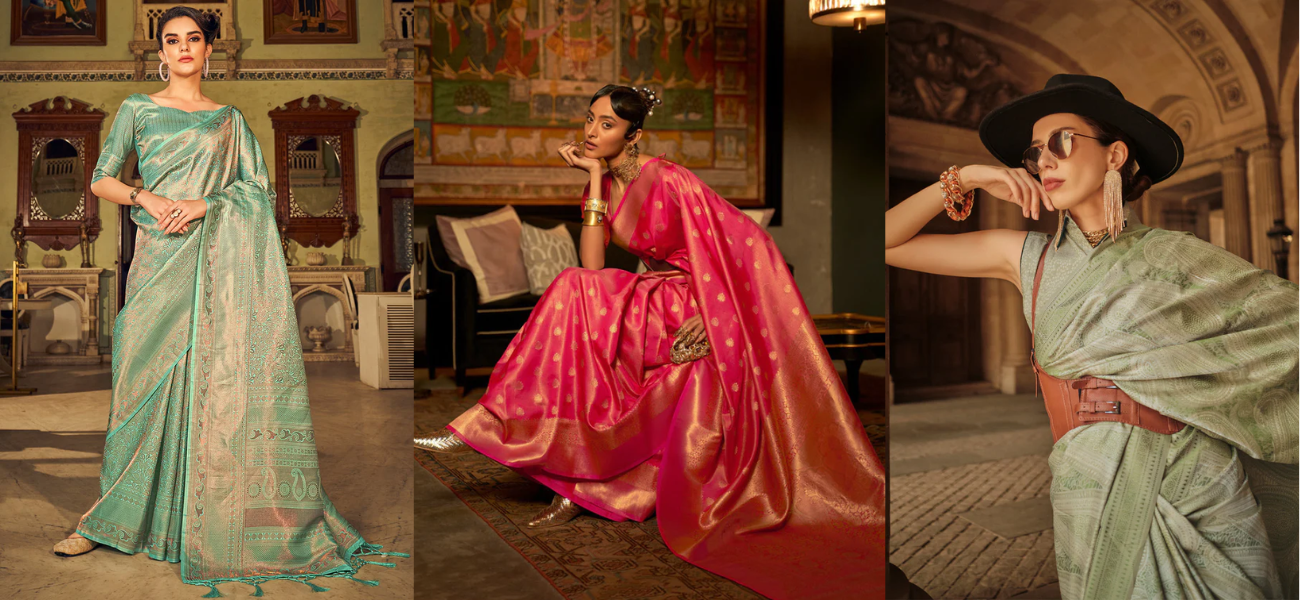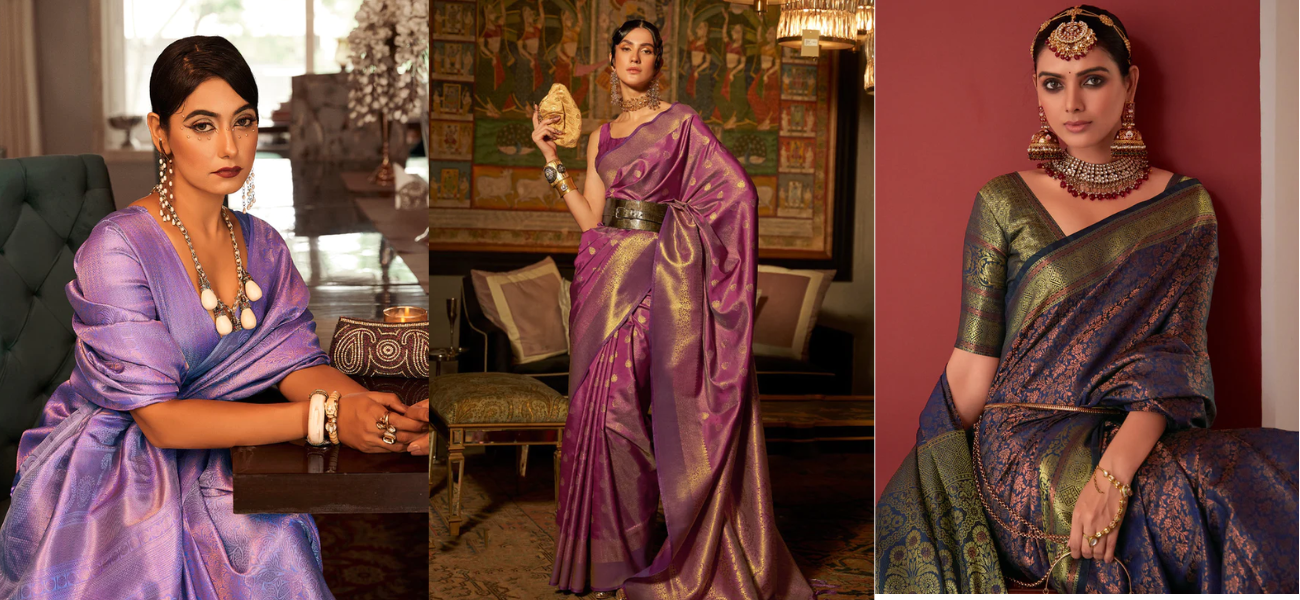
Kanjivaram Sarees: Types, Identification, and Maintenance
Kanjivaram sarees, also known as Kanchipuram sarees, originate from the town of Kanchipuram in the Indian state of Tamil Nadu. These sarees have a long and illustrious history that dates back several centuries. The town of Kanchipuram has been a center for silk weaving and textile production for over 400 years. The exact origins of Kanjivaram sarees can be traced back to the 5th century during the reign of the Chola dynasty. The uniqueness of Kanjivaram sarees lies in their distinct features. They are traditionally woven using pure mulberry silk threads, and the designs are inspired by temples, nature, and traditional motifs. The sarees are known for their heavy borders and pallus which are often adorned with intricate gold or silver zari work. Kanjivaram sarees are highly regarded not only for their beauty but also for their durability. They are considered a symbol of elegance and cultural heritage and are passed down through generations as heirlooms.
The uniqueness of Kanjivaram sarees lies in their distinct features. They are traditionally woven using pure mulberry silk threads, and the designs are inspired by temples, nature, and traditional motifs. The sarees are known for their heavy borders and pallus which are often adorned with intricate gold or silver zari work. Kanjivaram sarees are highly regarded not only for their beauty but also for their durability. They are considered a symbol of elegance and cultural heritage and are passed down through generations as heirlooms.
KANJIVARAM SAREE TYPES:
Kanjivaram sarees come in various types and designs, each with its unique characteristics:
Traditional Kanjivaram Sarees: These sarees are the quintessential Kanjivaram sarees known for their pure silk fabric, heavy zari work, and classic temple-inspired motifs. They often have broad borders and are available in a wide range of colors.
Lightweight Kanjivaram Sarees: While traditional Kanjivaram sarees are known for their heavy and ornate designs, lightweight Kanjivaram sarees are crafted with a focus on comfort and ease of wear. These sarees are more suitable for casual or semi-formal occasions.
Dual Tone Kanjivaram Sarees: Dual-tone Kanjivaram sarees are a popular variation of traditional Kanjivaram sarees, known for their striking and unique color combinations. The hallmark of dual-tone Kanjivaram sarees is the use of two contrasting colors. The choice of colors often depends on personal preferences and the latest fashion trends.
Plain Border Kanjivaram Sarees: These sarees have a relatively simpler border design compared to the traditional ones. They are favored by those who prefer a more understated and elegant look.
Handloom Kanjivaram Sarees: Handloom Kanjivaram sarees are woven entirely by hand, from the spinning of the silk threads to the weaving of the saree. Each saree is a labor-intensive work of art, often taking several weeks to complete. They continue to be a symbol of Indian heritage and are treasured by women across India and the world for their elegance and cultural significance.
How to identify a kanjivaram saree ?
- Kanjivaram sarees are made from high-quality pure mulberry silk. The silk should feel soft, smooth, and have a natural sheen. Rubbing the fabric gently between your fingers should create a subtle rustling sound.
- Kanjivaram sarees are renowned for their intricate zari work. Examine the saree's borders, pallu, and body for zari motifs and designs. The zari work should be rich and shiny.
- Kanjivaram sarees typically have a contrasting color or design for the pallu, creating a distinct contrast with the body of the saree. The pallu is often adorned with intricate zari work.
Tips to take care for your Kanjivaram sarees:
Maintaining authentic Kanjivaram sarees requires proper care to preserve their quality, appearance, and longevity. Here are some tips on how to care for your Kanjivaram sarees:
- Store your Kanjivaram sarees in a cool, dry place, away from direct sunlight, as prolonged exposure to sunlight can fade the colors.
- Use a cloth or muslin saree cover or a silk pouch to protect the saree from dust and moisture.
- Avoid hanging your sarees for extended periods as the weight of the fabric can cause stretching and distortion. Instead, fold them and stack them neatly.
- Only dry clean your Kanjivaram sarees to maintain their quality. Avoid washing them at home, as silk can be delicate, and improper washing can damage the fabric and zari work.
- Iron the saree at a moderate temperature to avoid scorching or burning the silk. Iron on the reverse side or place a cotton cloth between the saree and the iron to protect the zari work.
Proper care and maintenance of your Kanjivaram sarees will help ensure that they remain in excellent condition for years to come. These sarees are not only clothing but also works of art, and preserving them is an investment in both culture and tradition.
Hence, With a commitment to quality and authenticity, MySilkLove invites you to explore the beauty and artistry of Kanjivaram sarees, making your shopping experience a celebration of India's textile heritage and timeless elegance.








Leave a comment
This site is protected by hCaptcha and the hCaptcha Privacy Policy and Terms of Service apply.